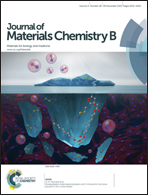Development of magnetic LuPO4 microspheres for highly selective enrichment and identification of phosphopeptides for MALDI-TOF MS analysis†
Abstract
Lichee-like core–shell structured magnetic lutetium phosphate (Fe3O4@LuPO4) affinity microspheres were successfully synthesized and well characterized. Based on the properties of great specificity and rapid separation, magnetic LuPO4 microspheres were applied to selectively enrich phosphopeptides for MALDI-TOF MS analysis. The enrichment performance of the prepared microspheres was demonstrated by tryptic digests of standard protein (β-casein), complex samples (tryptic digest mixture of β-casein and bovine serum albumin at different molar ratios of 1 : 10 to 1 : 50), and real biological samples (fresh pure milk and human serum), respectively. The enrichment ability of magnetic LuPO4 microspheres for phosphopeptides was very satisfying and the captured phosphopeptides with a sharp enhancement in MS signals were reliably identified based on the appearance of metastable ion peaks with poor resolution of the corresponding dephosphorylated peptides in the mass spectra. Enrichment of phosphopeptides by the Fe3O4@LuPO4 affinity microspheres provides a powerful approach for large scale phosphoproteome analysis.


 Please wait while we load your content...
Please wait while we load your content...